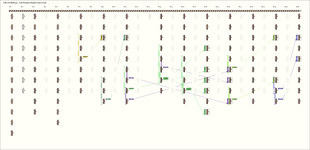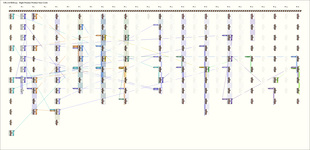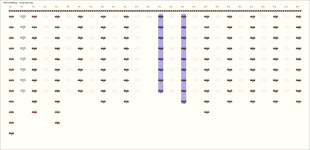| Notes: |
Ascher Databook Notes:
- A detached fragment of 9.0 cm. stored with the khipu has been assumed to be part of P5s3.
- UR1127, AS128, and UR1176 were acquired by the Museum in 1933 with provenance Nazca.
- By color, the khipu is separated in 25 groups. The first group is 12 pendants. Then there are 24 groups alternating in color pattern. Basically the pattern is a group of 8 pendants color W, followed by a group of 9 pendants colored RB, 7 DB, RB. (The exceptions t o the pattern are: groups 3, 5, and 17 each have an additional pendant between positions 1 and 2; groups 5, 7, and 9 each have an additional pendant between positions 8 and 9; in groups 7 and 9, position 4 is non-existent; and in group 7, position 2 is also non-existent. ) Starting with group 4, all groups of W pendants are of value 0 (or blank) and, in the alternate groups, all values in positions 1, 2, and 4 are 0 (or blank).
-
- The values in group 3, position by position, are the sums of the values in corresponding positions in groups 7, 9, 11, 13, 15, while the values in group 5 are the sums of values in groups 17, 19, 21, 23, 25. These values include all the subsidiary values on each pendant. The sums are exact (or off by at most 2 in one digit) for only 14 of the 18 positions.
- The values in group 1 are related to, but not exactly, the sums of values in groups 3 and 5, position by position. If at most one subsidiary is omitted when evaluating a position in group 1, then 8 of the 12 values in group 1 are the sums (+1 or 2) of the values in groups 3 and 5.
|

















